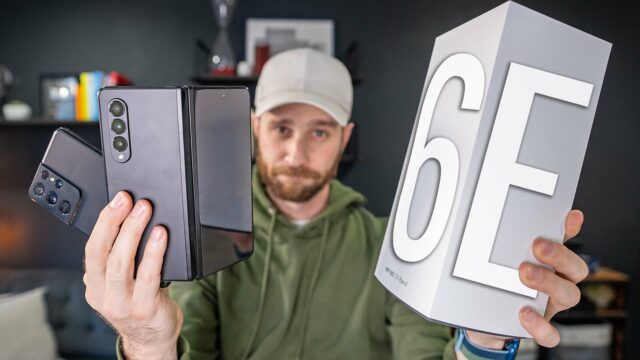Best Mesh WiFi 6 Routers for Every Scenario
Haven’t done one of these in a while so let’s do a best mesh wifi 6 routers video.
Now, I already did a best mesh routers video and a best wifi 6 routers video, but now that both technologies have matured enough there are a ton of routers that have the benefits of Wifi 6 like faster speeds, better handling of networks with a larger number of connected devices, better encryption, etc. (and you can check out my full Decodr episode on what wifi 6 is here if you want a deeper dive) and combined with the modularity and better range of mesh networks now (also have a Decodr episode on mesh wifi as well for a deeper dive on that here). The only question is now: what mesh wifi 6 router should you buy?
Well, I bought a ton of them and tested them all out and think I have a good list of the 4 I think will cover most people’s situations and budgets for a wifi 6 mesh router.
TP-Link Deco X20 (& Deco X90)
First up, we have the TP-Link Deco X20 AX1800 WiFi 6 mesh system, which is easily the least expensive option and the cheapest way for you to get the benefits of mesh and Wifi 6. Full disclosure: I bought all the routers on this list myself except for this one, which TP-Link sent over.
When you buy the Deco X20, it comes with three nodes that can cover up to 5,800 square feet and easily handle up to 150 devices connected at once (you can save even more and get a two-unit set for even less like I did here). The units are also small and don’t look ridiculous like some can so placing them around your house isn’t as much of a chore.
Also, we have two gigabit ethernet ports on each node so you can use any of them connected to your modem and still have a free ethernet port on that unit plus every other unit can then have two other ethernet devices connected. It also includes WPA3 encryption (a newer standard in WiFi 6 compared to the usual WPA2), an app that’s intuitive and easy to help you get setup, and you get a lifetime subscription to TP-Link’s own security and antivirus included whether you feel like using it or not.
For speed, it has an AX1800 rating so peak throughput is about 1.8Gbps.If you want a bit more range, speed with AX6600 and a 6.6Gbps throughput, and tri-band for a dedicated backhaul plus a 2.5Gb ethernet port, the TP-Link Deco X90 AX600 mesh system is a jump up for little bit more money.
By the way, I’ll leave links below to the best price I can find for each of the routers I mention here.For the TP-Link devices, since they sent them over, they also were kind enough to give a discount code which will give you X off for a limited time. Thought that was nice of them.
Netgear Orbi Wifi 6 + Mesh Extender + Cable Modem
Next up, we have the Netgear Orbi WiFi 6 router/modem combo plus mesh extender kit called the CBK752 for people using cable internet that want an all-in-one solution.
For the styling, I’m not really a fan as they are larger than any of the others on this list (but albeit smaller than other Orbi systems thankfully), but they do at least make up for some of that with having tri-band support with a 5ghz band dedicated to backhaul between the main router and it’s included satellite mesh unit. It also is the only one on this list that has a built-in DOCSIS 3.1 cable modem (which can support up to 10gbps internet connections aka most likely whatever speed you probably have from your cable internet provider).
So, with all the others on this list, you’ll need to use your normal cable modem that you most likely received from your ISP and then plug the router into it to use it, whereas with this one, you can actually completely replace your cable modem/router combo and plug the cable from the wall directly into the main router unit and be good to go. You will have to check with your ISP on how to do that (and it’ll only work for cable internet not fiber) but most cable providers support it and it’s not too hard to do. An interesting side benefit of this though, is that most cable ISPs charge you a monthly rental fee for your modem which you may or may not be aware of, but if you replace the modem they gave you with this for example, you save that money every month. Something to think about.
Beyond that, the two unit system has a range of about 5000 square feet, the aforementioned tri-band support with dedicated WiFi 6 backhaul channel, and with a AX4200 rating, you have a theoretical max throughput speed of 4.2Gbps.
For ports, we have the 4 ethernet ports on the main unit (in addition to the coax port for the incoming cable internet) and we have 2 ethernet ports on the satellite unit. So might be better if you have a ton of things you plug in to your router next to your modem since you’ll get four for that.
Pricing is more than the TP-Links, as expected, but again I’ll leave the best prices that I can find below.
Linksys MX10 Velop WiFi 6 Mesh Kit
For something with a bit faster theoretically speaking and bit more coverage, we now turn to the Linksys MX10 Velop which I can only guess is short for envelope as in it envelopes you in Wifi?Regardless, it also has tri-band support with a dedicated 5ghz WiFi 6 backhaul between the two units that it comes with. We have 12 streams of WiFi, a device load of 50 plus devices, and each of the units can cover up to 3000 square feet–so this two pack can cover 6000.
Each unit also has 5 gigabit ethernet ports on it which is handy if you need to plug in more devices via wired connections (keep in mind one of them will be used for the incoming internet from your current modem on the unit you place next to that). And as with any of these mesh systems, you can always buy more units if you need to extend coverage (3 is 9000 sq ft, 4 is 12,000, etc.).
I also personally like the styling of them as they feel super minimalistic with clean lines, etc. and don’t mind having them out in the open.
Their biggest downside is, of course, the price as its so far the highest on this list by a bit (I’ll again leave the best prices I can find below, and also, when you see our last option, this will look cheaper by comparison, at least). Either way though, probably a good option for people who need the extra coverage using less nodes, are doing a lot of streaming/gaming/etc. and might even need to plug in a decent amount via ethernet.
AmpliFi Alien WiFi 6 + MeshPoint
This brings us to the last, and easily the most expensive on this list: the AmpliFi Alien WiFi 6 plus MeshPoint system.
Despite the highest price on this list by a decent margin, it is probably also the most high-tech interface-wise and definitely the most distinguished looks-wise. The box literally describes the units as “showcase pieces in your home”.
We have a matte black design with a ring of LEDs at the bottom with a green-ish glow as well as a large LCD touchscreen on the front. That touchscreen will show you things like your internet and network speeds, devices that are connected, and a whole host of other interesting if not that useful information but also useful information like if there’s a software update, the internet goes down, etc. Frankly, I just like the idea of it being something other than just blinking lights. If you would rather it be more subtle though, you can easily change what is displayed and even turn off the display entirely, as well as the LED.
The app is also pretty intuitive and equally visually interesting and does similar things to all the others on this list. The one interesting exception is that Ubiquiti (the company that makes it) also gives you a free VPN service called AmpliFi Teleport VPN. You can then open the Teleport app on your iPhone or Android device (it doesn’t currently work for laptops yet) and it’ll send all the internet traffic through your home network with extra encryption on it. This is good for hiding your info while surfing but might also be useful if you’re say traveling and want to access Netflix from your home country while in another one (as apps on your device will think they’re being used in your house).
For specs, we have tri-band as well but no dedicated Wifi 6 backhaul unlike some of the others on the list. It has one 5ghz wifi 6, one 5ghz wifi 5, and a 2.4ghz wifi band and by default dynamically switches between them as needed. You could turn the wifi 6 5ghz band into a dedicated backhaul using the app, but then the only other 5ghz band you have for devices isn’t wifi 6 which is odd). But we have a theoretical throughput of about 7.7gbps though, and the two units can cover up to 6000 sq ft together.
But there you go, the best mesh WiFi 6 systems I could find. Let me know what you think and feel free to leave other options I might have missed in the comments below!




